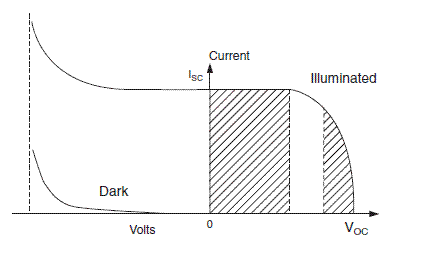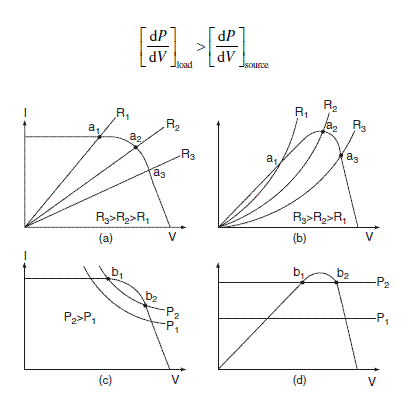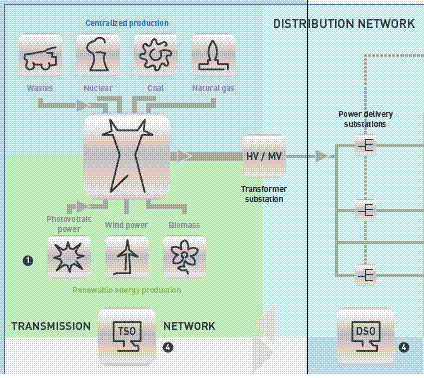- This topic has 4 replies, 1 voice, and was last updated 2 years, 11 months ago by
asghari.
-
CreatorTopic
-
2021-08-03 at 11:08 am #847
PhamQuocPhuc
Can you relay to me one question? How is transient stability of solar power? Have You document about transient stability solar power?
Can you relay to me one question? How is transient stability of solar power? Have You document about transient stability solar power? -
CreatorTopic
-
AuthorReplies
-
2021-08-03 at 11:08 am #2777
Hamid
Fundamentally the electrical characteristic of the PV cell is generally represented by the current vs. voltage (I-V) curve. Figure below shows the I-V characteristic of a PV module under two conditions, in sunlight and in the dark. In the first quadrant, the top left of the I-V curve at zero voltage is called the short-circuit current.
 This is the current we would measure with output terminals shorted (zero voltage). The bottom right of the curve at zero current is called the open-circuit voltage. This is the voltage we would measure with output terminals open (zero current). In the left-shaded region, the cell works as a constant current source, generating a voltage to match with the load resistance. In the shaded region on the right, the current drops rapidly with a small rise in the voltage. In this region, the cell works like a constant voltage source with an internal resistance. Somewhere in the middle of the two shaded regions, the curve has a knee point. If a voltage is externally applied in the reverse direction, for instance, during a system fault transient, the cell current remains flat, and the power is absorbed by the cell with a negative voltage and positive current. However, beyond a certain negative voltage, the junction breaks down as in a diode, and the current rises to a high value. In the dark, the current is zero for any voltage up to the breakdown voltage, which is the same as in the illuminated condition. The power output of the panel is the product of the voltage and current outputs. In Figure below, the power is plotted against the voltage. Note that the cell produces no power at zero voltage or zero current, and produces the maximum power at the voltage corresponding to the knee point of the I-V curve. This is why the PV power circuit is always designed to operate close to the knee point with a slight slant on the left-hand side. The PV circuit is modeled approximately as a constant current source in the electrical analysis of the system.
This is the current we would measure with output terminals shorted (zero voltage). The bottom right of the curve at zero current is called the open-circuit voltage. This is the voltage we would measure with output terminals open (zero current). In the left-shaded region, the cell works as a constant current source, generating a voltage to match with the load resistance. In the shaded region on the right, the current drops rapidly with a small rise in the voltage. In this region, the cell works like a constant voltage source with an internal resistance. Somewhere in the middle of the two shaded regions, the curve has a knee point. If a voltage is externally applied in the reverse direction, for instance, during a system fault transient, the cell current remains flat, and the power is absorbed by the cell with a negative voltage and positive current. However, beyond a certain negative voltage, the junction breaks down as in a diode, and the current rises to a high value. In the dark, the current is zero for any voltage up to the breakdown voltage, which is the same as in the illuminated condition. The power output of the panel is the product of the voltage and current outputs. In Figure below, the power is plotted against the voltage. Note that the cell produces no power at zero voltage or zero current, and produces the maximum power at the voltage corresponding to the knee point of the I-V curve. This is why the PV power circuit is always designed to operate close to the knee point with a slight slant on the left-hand side. The PV circuit is modeled approximately as a constant current source in the electrical analysis of the system.  The operating point of any power system is the intersection of the source line and the load line. If the PV source having the I-V and P-V characteristics shown in Figure (a) is supplying power to a resistive load R1, it will operate at point A1. If the load resistance increases to R2 or R3, the operating point moves to A2 or A3, respectively. The maximum power is extracted from the module when the load resistance is R2 (Figure b). Such a load that matches with the source is always necessary for the maximum power extraction from a PV source. The operation with a constant-power load is shown in Figure (c) and Figure (d). The constant-power load line has two points of intersection with the source line, denoted by B1 and B2. Only the point B2 is stable, as any perturbation from it generates a restoring power to take the operation back to B2, and the system continues to operate at B2 with an inherent stability. Therefore, the necessary condition for the electrical operating stability of the solar array is as follows:
The operating point of any power system is the intersection of the source line and the load line. If the PV source having the I-V and P-V characteristics shown in Figure (a) is supplying power to a resistive load R1, it will operate at point A1. If the load resistance increases to R2 or R3, the operating point moves to A2 or A3, respectively. The maximum power is extracted from the module when the load resistance is R2 (Figure b). Such a load that matches with the source is always necessary for the maximum power extraction from a PV source. The operation with a constant-power load is shown in Figure (c) and Figure (d). The constant-power load line has two points of intersection with the source line, denoted by B1 and B2. Only the point B2 is stable, as any perturbation from it generates a restoring power to take the operation back to B2, and the system continues to operate at B2 with an inherent stability. Therefore, the necessary condition for the electrical operating stability of the solar array is as follows:  Some loads such as heaters have constant resistances, which absorb power that varies with the square of the voltage. Other loads such as induction motors behave more like constant-power loads. They draw more current at lower voltage and vice versa. In most large systems with mixed loads, the power varies approximately in a linear proportion with voltage. The solar power generation transient stability in huge power systems is subjected to new research about influence of increasing amounts of new technologies for electrical power generation. Many of these new technologies do not use a conventional grid coupled synchronous generator to convert primary energy into electricity. Instead, they use a squirrel cage or doubly fed induction generator (some wind turbine concepts) or a synchronous or squirrel cage induction generator that is grid connected through a power electronic converter (other wind turbine concepts, small scale high speed gas turbines). In the case of solar panels and fuel cells, it is not even mechanical power that is converted into electricity. A further difference between these new technologies and conventional means of electrical power generation is that many of them are of considerably smaller size than conventional thermal, nuclear and hydro units that up to this moment deliver the majority of the electrical power consumed worldwide. Therefore, they are often connected to low and medium voltage grids and not to the high voltage transmission grid, resulting in longer electrical distances. As long as the penetration level of these new technologies in power systems is still low and they only cover a minor fraction of the system load, they hardly impact the dynamic behavior of a power system. Therefore, in power system dynamics and transient stability studies, they are normally considered as negative load and their intrinsic dynamics and their controllers, if present, are not taken into account. However, if the amount of new generation technology introduced in a power system becomes substantial, it may start to influence the overall behavior of this system. The power electronic converter is modeled as a source of active power (P) and reactive power (Q). This is necessary because the grid representation in power system dynamics simulation software and the typical time step used do not allow detailed modeling of power electronics and its controllers for both theoretical and practical reasons. The prime mover of the synchronous and asynchronous generators and the primary side of the generators grid coupled through a power electronic converter is not taken into account, because they are not of major importance in this study. The connection of distributed generation grid coupled through a power electronics interface results in a decrease in the maximum rotor speed deviation of the synchronous generators. This is caused by the fact that distributed generators are quickly disconnected by their power electronic converters when a fault occurs, because of the terminal voltage drop. Thus, a lot of generation is lost in case of a fault, reducing the acceleration of the rotors of the synchronous generators. This also explains why the over speeding is further reduced, when more distributed generation is connected: the amount of generation lost at the fault increases, resulting in a decreasing rotor acceleration. The observation that the maximum rotor speed deviation is the same in the cases of controlled and uncontrolled distributed generators can be explained as follows. The maximum rotor speed deviation is reached during the fault. However, during the fault, both uncontrolled and controlled distributed generators grid coupled through a power electronics interface are disconnected. Therefore, neither the uncontrolled nor the controlled generators are on line during the fault and as a result, the maximum rotor speed deviation is the same in both cases.
Some loads such as heaters have constant resistances, which absorb power that varies with the square of the voltage. Other loads such as induction motors behave more like constant-power loads. They draw more current at lower voltage and vice versa. In most large systems with mixed loads, the power varies approximately in a linear proportion with voltage. The solar power generation transient stability in huge power systems is subjected to new research about influence of increasing amounts of new technologies for electrical power generation. Many of these new technologies do not use a conventional grid coupled synchronous generator to convert primary energy into electricity. Instead, they use a squirrel cage or doubly fed induction generator (some wind turbine concepts) or a synchronous or squirrel cage induction generator that is grid connected through a power electronic converter (other wind turbine concepts, small scale high speed gas turbines). In the case of solar panels and fuel cells, it is not even mechanical power that is converted into electricity. A further difference between these new technologies and conventional means of electrical power generation is that many of them are of considerably smaller size than conventional thermal, nuclear and hydro units that up to this moment deliver the majority of the electrical power consumed worldwide. Therefore, they are often connected to low and medium voltage grids and not to the high voltage transmission grid, resulting in longer electrical distances. As long as the penetration level of these new technologies in power systems is still low and they only cover a minor fraction of the system load, they hardly impact the dynamic behavior of a power system. Therefore, in power system dynamics and transient stability studies, they are normally considered as negative load and their intrinsic dynamics and their controllers, if present, are not taken into account. However, if the amount of new generation technology introduced in a power system becomes substantial, it may start to influence the overall behavior of this system. The power electronic converter is modeled as a source of active power (P) and reactive power (Q). This is necessary because the grid representation in power system dynamics simulation software and the typical time step used do not allow detailed modeling of power electronics and its controllers for both theoretical and practical reasons. The prime mover of the synchronous and asynchronous generators and the primary side of the generators grid coupled through a power electronic converter is not taken into account, because they are not of major importance in this study. The connection of distributed generation grid coupled through a power electronics interface results in a decrease in the maximum rotor speed deviation of the synchronous generators. This is caused by the fact that distributed generators are quickly disconnected by their power electronic converters when a fault occurs, because of the terminal voltage drop. Thus, a lot of generation is lost in case of a fault, reducing the acceleration of the rotors of the synchronous generators. This also explains why the over speeding is further reduced, when more distributed generation is connected: the amount of generation lost at the fault increases, resulting in a decreasing rotor acceleration. The observation that the maximum rotor speed deviation is the same in the cases of controlled and uncontrolled distributed generators can be explained as follows. The maximum rotor speed deviation is reached during the fault. However, during the fault, both uncontrolled and controlled distributed generators grid coupled through a power electronics interface are disconnected. Therefore, neither the uncontrolled nor the controlled generators are on line during the fault and as a result, the maximum rotor speed deviation is the same in both cases.  Reference: Impacts of Distributed Generation on Power System Transient Stability J.G. Slootweg Member IEEE W.L. Kling Member IEEE Electrical Power Systems, Faculty 2021-08-03 at 11:08 am #3247
Reference: Impacts of Distributed Generation on Power System Transient Stability J.G. Slootweg Member IEEE W.L. Kling Member IEEE Electrical Power Systems, Faculty 2021-08-03 at 11:08 am #3247asghari
why in constant power load B2 point is equilibrium point?
2021-08-03 at 11:08 am #3248Hamid
According to illustrated PV/IV curve, the slope of curve in B1 is positive and in B2 is negative. It means each decreasing of voltage due to load variation in B2 point can be caused the power/current generation increasing which can restore the system to last position.
2021-08-03 at 11:08 am #3263asghari
answer of this question is in paper “Hyunsu Bae; Jaeho Lee; Sanghyun Park; Bo Cho; , “Large-signal stability analysis of solar array power system,” Aerospace and Electronic Systems, IEEE Transactions on , vol.44, no.2, pp.538-547, April 2008″
-
AuthorReplies
- You must be logged in to reply to this topic.
